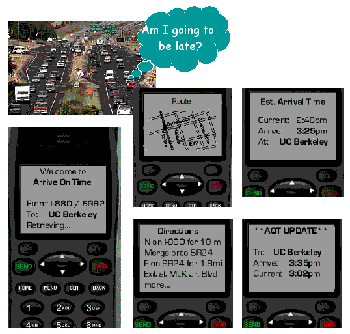|
HOME | SEARCH | ARCHIVE |
|
New traffic monitoring system
could reduce commute times
![]()
By Catherine Zandonella,
Public Affairs
| |
|
24 Jan 2001 | Drivers who rely on radio traffic reports may soon have an easier way to navigate the dreaded freeway commute.
Professor Pravin Varaiya and his team of students have developed a way to get updates on traffic hotspots, alternative routes and travel times - up to an hour in advance - via the Internet or cellular phone.
The freeway Performance Evaluation Monitoring System, or PeMS, was unveiled Jan. 18 at a Berkeley-sponsored Bay Area transportation town meeting. Developed by Varaiya, professor of computer science and electrical engineering, PeMS converts freeway monitoring data into real-time traffic updates accessible via a Web portal.
Varaiya is one of the main researchers in the proposed Berkeley-led Center for Information Technology Research in the Interest of Society. A joint program with UC Davis, UC Santa Cruz and UC Merced, CITRIS is a research initiative dedicated to creating technology to improve everyday living.
Currently PeMS is only available to engineers at the California Department of Transportation and to the research community. But Varaiya hopes his invention will soon enjoy widespread use through Internet service providers and public agency traveler information efforts.
At the heart of Varaiya's invention is software that converts data from Caltrans' existing vehicle detection network into easy-to-read tables and graphs. The PeMS Web page provides a map of the entire freeway system in a given urban area. A color-coded link provides the freeway speed, and an animation shows how congestion starts and spreads. By selecting an origin and destination on the map, the user can see how long each route to the destination will take. PeMS also analyses traffic patterns and predicts travel times up to an hour in advance.
While PeMS has obvious advantages for commuters, Varaiya, who is Berkeley's Nortel Networks Distinguished Professor, originally designed the system to help Caltrans officials monitor traffic patterns. "PeMS can be used by managers to get an overall view of traffic trends, by engineers to spot and eliminate bottlenecks and help them design solutions, by planners to evaluate proposals for new routes," Varaiya said.
Caltrans officials have already begun using PeMS. "The real benefit of PeMS is it gives us a better understanding of what is happening on the freeways," said John Wolf, chief of the Office of System Management Planning in the Caltrans Traffic Operations Program.
According to Varaiya's calculations, appropriate traffic management in the Los Angeles area could save more than $1 billion per year in lost time and fuel costs. And this estimate did not include costs associated with pollution, increased accidents or stress. Using PeMS, Varaiya found that the most efficient way to reduce commute times is to keep freeway traffic moving at 60 miles per hour. The best way to maintain this speed during peak use hours, he said, is to limit the number of cars allowed onto the freeway. This could mean longer waits at on-ramps, but, overall, the trip time would be shortened.
Varaiya envisions a system where drivers could be notified of the best time to leave for the journey. "Instead of being parked on the freeway, you could spend ten more minutes on your coffee break or in your office," he said.
In addition to its use in traffic management, PeMS can predict travel times. For example, a 40-mile trip across Los Angeles on Interstate 10 can take from 40 to 130 minutes, depending on traffic. By accessing PeMS, a traveler could inform business clients of her arrival time.
Although the software for each urban area must be customized, a new Caltrans district can be added within weeks. Varaiya and his students are currently adapting software for Los Angeles, which generates one one billion bytes of data per day. The entire state generates an average of two gigabytes per day.
PeMS is not yet applicable in the Bay Area, where traffic has worsened dramatically in the past five years, said Varaiya. But Caltrans has recently increased availability of data from the detectors at least 10-fold, said Judy Chen, chief of the Caltrans Office of Traffic Systems.
Caltrans also feeds data to TravInfo, a traffic information system - dial 817-1717 in the nine-county Bay Area - maintained by the Metropolitan Transportation Commission. But PeMS provides more detailed analyses that can be used for research.
Each vehicle-counting device, or loop detector, consists of an electrical wire buried in the pavement. When a vehicle passes over the wire, the metal in the vehicle causes fluctuations in the electric current. A detector that monitors a four-lane highway can cost $100,000 or more.
Related links:
California
PATH
Center for Information Technology
Research in the Interest of Society
Home | Search | Archive | About | Contact | More News
Copyright 2001, The Regents of the University of California.
Produced and maintained by the Office of Public Affairs at UC Berkeley.
Comments? E-mail berkeleyan@pa.urel.berkeley.edu.
